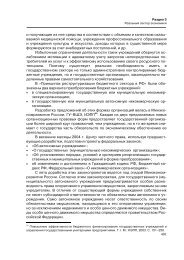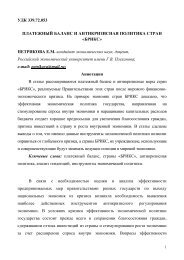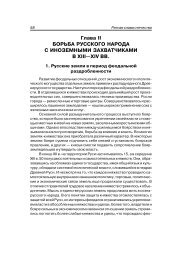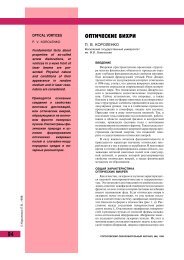primarily resulted <strong>in</strong> <strong>the</strong> capability of <strong>the</strong> U.S. naval component of <strong>the</strong> triad (which was traditionallyconsiderably bigger than <strong>the</strong> same component of <strong>the</strong> Soviet strategic forces) to deliver surprisestrikes aga<strong>in</strong>st hardened targets. In addition to means of destruction of high-priority hardenedtargets like ICBM launch silos of <strong>the</strong> Soviet <strong>Strategic</strong> Missile Forces (SMF), <strong>the</strong> developmentof U.S. military capacity stipulated (<strong>in</strong> <strong>the</strong> event of implementation of recently projected programs)a large number of means of target destruction, which (although hardened) had a limitedcapability of avoid<strong>in</strong>g such strikes; <strong>in</strong> particular, that was <strong>the</strong> designated purpose of <strong>the</strong> aircraftcomponent of <strong>the</strong> triad. 76In-depth scientific contemplation of <strong>the</strong> ecological, climatic, biomedical <strong>and</strong> o<strong>the</strong>r various consequencesof nuclear war constituted an important part of <strong>the</strong> great debates of <strong>the</strong> 1980s on <strong>the</strong>problems of SDI <strong>and</strong> strategic stability as a whole. This certa<strong>in</strong>ly contributed to a better underst<strong>and</strong><strong>in</strong>gby <strong>the</strong> political <strong>and</strong> military elites on both sides of <strong>the</strong> entirety of <strong>the</strong> catastrophic consequencesof us<strong>in</strong>g nuclear weapons—especially if such weapons are ever used on a massive scale.In <strong>the</strong> modern context of <strong>the</strong> 2000s, it is necessary to bear <strong>in</strong> m<strong>in</strong>d that <strong>the</strong> perception of <strong>the</strong>threat of annihilation of our civilization, <strong>and</strong> <strong>the</strong> very real possibility of <strong>the</strong> Earth be<strong>in</strong>g destroyedas a result of a nuclear exchange, has considerably waned. This is illustrated <strong>in</strong> particular by <strong>the</strong>mutual military <strong>and</strong> political rhetoric of <strong>the</strong> elites of Pakistan <strong>and</strong> India <strong>in</strong> <strong>the</strong> course of one of <strong>the</strong>sharp crises <strong>in</strong> <strong>the</strong>ir relations after <strong>the</strong>y acquired <strong>the</strong>ir own nuclear weapons.40<strong>Ensur<strong>in</strong>g</strong> <strong>Strategic</strong> <strong>Stability</strong> <strong>in</strong> <strong>the</strong> <strong>Past</strong> <strong>and</strong> <strong>Present</strong>: Theoretical <strong>and</strong> Applied Questions
Chapter 9: Latest Trends <strong>in</strong> <strong>the</strong> Development on Nonnuclear Weaponry, <strong>the</strong>Forms <strong>and</strong> Methods of Conventional Combat <strong>and</strong> <strong>the</strong>ir Impact on <strong>Strategic</strong><strong>Stability</strong>In <strong>the</strong> 1980s, experts from <strong>the</strong> Soviet Union, <strong>the</strong> United States <strong>and</strong> member states of <strong>the</strong> WarsawPact Organization <strong>and</strong> NATO actively discussed <strong>the</strong> aspects of secur<strong>in</strong>g strategic stability withrespect to conventional weapons <strong>and</strong> conventional armed forces <strong>in</strong> Europe. 77 An important role<strong>in</strong> those discussions was played not just by <strong>the</strong> U.S. <strong>and</strong> Soviet experts, but also by experts fromGermany, <strong>the</strong> Ne<strong>the</strong>rl<strong>and</strong>s, Pol<strong>and</strong> <strong>and</strong> Hungary. By no means unimportant were <strong>the</strong> discussionsregard<strong>in</strong>g various formulas of “non-offensive defense” <strong>and</strong> “non-provocative defense.” Suchdiscussions resulted <strong>in</strong> <strong>the</strong> development of formulas of limitation <strong>and</strong> reduction of conventionalarms, as well as new doctr<strong>in</strong>al tenets.The issues of limitation of <strong>the</strong> sides’ offensive capabilities <strong>and</strong> limitation of <strong>the</strong> types of peacetimemilitary activities that <strong>in</strong>crease <strong>the</strong> capability of large-scale warfare with <strong>the</strong> use of generalpurposemeans <strong>and</strong> forces <strong>and</strong> conventional arms rema<strong>in</strong> quite topical today. 78 Certa<strong>in</strong>ly, <strong>in</strong> thisrespect it is necessary to take full account of <strong>the</strong> latest trends <strong>in</strong> development of <strong>the</strong> art of war thatare tak<strong>in</strong>g shape as a result of what is called <strong>the</strong> “revolution <strong>in</strong> <strong>the</strong> military arts.” 79 In addition, itis necessary to take <strong>in</strong>to account <strong>the</strong> sharply <strong>in</strong>creased role of <strong>in</strong>formation <strong>and</strong> communicationstechnologies, network-centric warfare, new electronic warfare capabilities, <strong>and</strong> robotization ofstrik<strong>in</strong>g <strong>and</strong> auxiliary assets (<strong>the</strong> grow<strong>in</strong>g roles of unmanned reconnaissance-strike complexes, aswell as strategic, operational <strong>and</strong> tactical-mobility assets, are all sh<strong>in</strong><strong>in</strong>g examples). 80A more <strong>and</strong> more important role <strong>in</strong> ensur<strong>in</strong>g efficient warfare is played by supercomputers, def<strong>in</strong>edas computers that have a process<strong>in</strong>g speed of more than 1 teraflop, which means <strong>the</strong>y canperform more than 1 trillion float<strong>in</strong>g-po<strong>in</strong>t operations per second. In this same category are <strong>the</strong>networks of such computers; <strong>the</strong> warfare models that are simulated us<strong>in</strong>g such computers; <strong>and</strong> <strong>the</strong>generation of logistic <strong>and</strong> decision-mak<strong>in</strong>g models (<strong>in</strong>clud<strong>in</strong>g those developed with <strong>the</strong> use of artificial<strong>in</strong>telligence technologies), both at <strong>the</strong> operational strategic <strong>and</strong> political-military levels. All<strong>the</strong>se means serve as a powerful multiplier of combat capabilities. (With<strong>in</strong> <strong>the</strong> next 3 to 5 years,<strong>the</strong> comm<strong>and</strong> <strong>and</strong> control systems of <strong>the</strong> most developed countries will be equipped with 1-petaflopsupercomputers that can perform 1 thous<strong>and</strong>-trillion float<strong>in</strong>g-po<strong>in</strong>t operations per second.)We have witnessed <strong>the</strong> transformation of electronic warfare from an auxiliary, support<strong>in</strong>g capacityto one of <strong>the</strong> pr<strong>in</strong>cipal combat tools (unfortunately, <strong>the</strong> Russian Armed Forces have yet to fullyrealize this fact). Moreover, electronic warfare no longer means just electronic countermeasures(ECM); it is becom<strong>in</strong>g a more sophisticated confrontation <strong>in</strong>strument, both <strong>in</strong> peacetime <strong>and</strong> <strong>in</strong>time of war, which requires high <strong>in</strong>tellect <strong>and</strong> professionalism. 81The <strong>in</strong>-depth study of <strong>the</strong> medium-term, long-term <strong>and</strong> very-long-term trends <strong>in</strong> <strong>the</strong> developmentof <strong>the</strong> military arts shows that strategic, operational, <strong>and</strong> tactical mobility is becom<strong>in</strong>g aprevail<strong>in</strong>g pr<strong>in</strong>ciple of warfare. Mobility <strong>in</strong> <strong>the</strong> real actions of <strong>the</strong> armed forces of different countriesis a more important factor than any concentration of military power at <strong>the</strong> ma<strong>in</strong> po<strong>in</strong>t ofattack; <strong>in</strong> a number of <strong>in</strong>stances, it even substitutes for <strong>the</strong> latter.Belfer Center for Science <strong>and</strong> International Affairs | Harvard Kennedy School 41
















